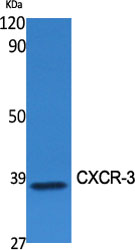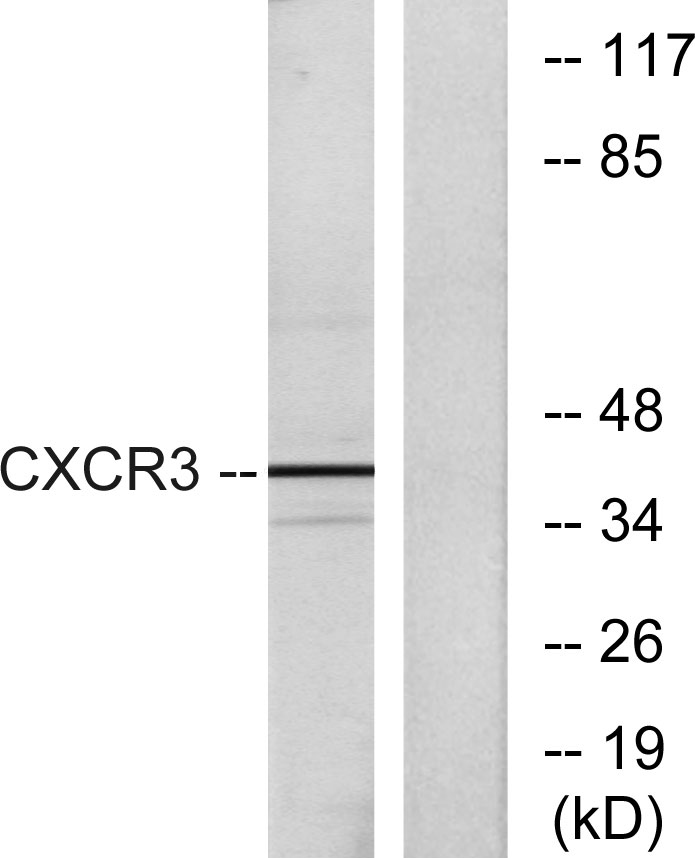CXCR-3 Polyclonal Antibody
- Catalog No.:YT1161
- Applications:WB;ELISA
- Reactivity:Human;Rat;Mouse;
- Target:
- CXCR-3
- Fields:
- >>Cytokine-cytokine receptor interaction;>>Viral protein interaction with cytokine and cytokine receptor;>>Chemokine signaling pathway
- Gene Name:
- CXCR3
- Protein Name:
- C-X-C chemokine receptor type 3
- Human Gene Id:
- 2833
- Human Swiss Prot No:
- P49682
- Mouse Swiss Prot No:
- O88410
- Immunogen:
- The antiserum was produced against synthesized peptide derived from human CXCR3. AA range:161-210
- Specificity:
- CXCR-3 Polyclonal Antibody detects endogenous levels of CXCR-3 protein.
- Formulation:
- Liquid in PBS containing 50% glycerol, 0.5% BSA and 0.02% sodium azide.
- Source:
- Polyclonal, Rabbit,IgG
- Dilution:
- WB 1:500 - 1:2000. ELISA: 1:5000. Not yet tested in other applications.
- Purification:
- The antibody was affinity-purified from rabbit antiserum by affinity-chromatography using epitope-specific immunogen.
- Concentration:
- 1 mg/ml
- Storage Stability:
- -15°C to -25°C/1 year(Do not lower than -25°C)
- Other Name:
- CXCR3;GPR9;C-X-C chemokine receptor type 3;CXC-R3;CXCR-3;CKR-L2;G protein-coupled receptor 9;Interferon-inducible protein 10 receptor;IP-10 receptor;CD antigen CD183
- Observed Band(KD):
- 40kD
- Background:
- C-X-C motif chemokine receptor 3(CXCR3) Homo sapiens This gene encodes a G protein-coupled receptor with selectivity for three chemokines, termed CXCL9/Mig (monokine induced by interferon-g), CXCL10/IP10 (interferon-g-inducible 10 kDa protein) and CXCL11/I-TAC (interferon-inducible T cell a-chemoattractant). Binding of chemokines to this protein induces cellular responses that are involved in leukocyte traffic, most notably integrin activation, cytoskeletal changes and chemotactic migration. Alternatively spliced transcript variants encoding different isoforms have been found for this gene. One of the isoforms (CXCR3-B) shows high affinity binding to chemokine, CXCL4/PF4 (PMID:12782716). [provided by RefSeq, Jun 2011],
- Function:
- function:Receptor for CXCL9, CXCL10 and CXCL11 and mediates the proliferation of human mesangial cells (HMC). Isoform 2 is a receptor for CXCL4 and also mediates the inhibitory activities of CXCL9, CXCL10 and CXCL11 on the growth of human microvascular endothelial cells (HMVEC). Isoform 2 may play a role in angiogenesis. Isoform 3 mediates activity of CXCL11.,online information:CXC chemokine receptors entry,similarity:Belongs to the G-protein coupled receptor 1 family.,tissue specificity:Isoform 1 and isoform 2 are mainly expressed in heart, kidney, liver and skeletal muscle. Isoform 1 is also expressed in placenta.,
- Subcellular Location:
- [Isoform 1]: Cell membrane ; Multi-pass membrane protein .; [Isoform 2]: Cell membrane ; Multi-pass membrane protein .
- Expression:
- Isoform 1 and isoform 2 are mainly expressed in heart, kidney, liver and skeletal muscle. Isoform 1 is also expressed in placenta. Isoform 2 is expressed in endothelial cells. Expressed in T-cells (at protein level).
- June 19-2018
- WESTERN IMMUNOBLOTTING PROTOCOL
- June 19-2018
- IMMUNOHISTOCHEMISTRY-PARAFFIN PROTOCOL
- June 19-2018
- IMMUNOFLUORESCENCE PROTOCOL
- September 08-2020
- FLOW-CYTOMEYRT-PROTOCOL
- May 20-2022
- Cell-Based ELISA│解您多样本WB检测之困扰
- July 13-2018
- CELL-BASED-ELISA-PROTOCOL-FOR-ACETYL-PROTEIN
- July 13-2018
- CELL-BASED-ELISA-PROTOCOL-FOR-PHOSPHO-PROTEIN
- July 13-2018
- Antibody-FAQs
- Products Images

- Western Blot analysis of various cells using CXCR-3 Polyclonal Antibody
.jpg)
- Western Blot analysis of K562 cells using CXCR-3 Polyclonal Antibody

- Western blot analysis of lysates from K562 cells, using CXCR3 Antibody. The lane on the right is blocked with the synthesized peptide.



